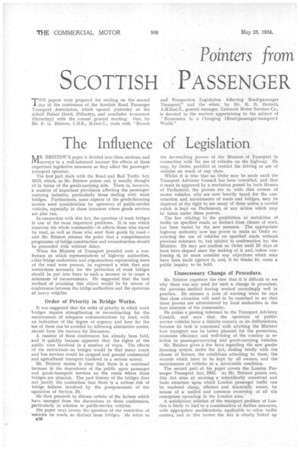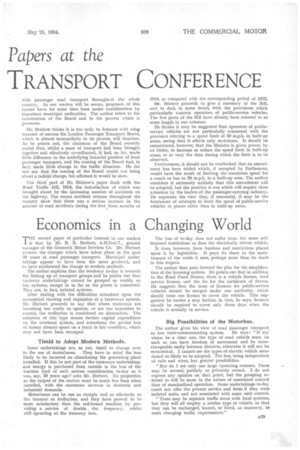Pointers from Papers at the
Page 56

Page 57

If you've noticed an error in this article please click here to report it so we can fix it.
SCOTTISH PASSENGER TRANSPORT CONFERENCE
The Influence of Legislation
AAR. BRISTOW'S paper is divided into three sections, and 1V1surveys in a well-informed manner the effects of three important legislative measures as they affect the passengertransport operator.
The first part deals with the Road and Rail Traffic Act, 1033, which, as Mr. Bristow points out, is usually thought of in terms of the goods-carrying side. There is, however, a number of important provisions affecting the passengercarrying industry, particularly those dealing with weak bridges. Furthermore, some aspects of the goods-licensing system need consideration by operators of public-service vehicles, especially in those instances where goods services are also run.
In connection with this Act, the question r,f weak bridges is one of the most important problems. It is one which concerns the whole community—it affects those who travel by road, as well as those who send their goods by road— and Mr. Bristow stresses the point that a comprehensive programme of bridge construction and reconstruction should be proceeded with without delay.
When the Minister of Transport presided over a conference at which representatives of highway authorities, other bridge authorities and organizations representing users of the road were present, he expressed a wish that any restrictions necessary for the protection of weak bridges should be put into force in such a manner as to cause a minimum of inconvenience. He suggested that the best method of attaining this object would be by means of conferences between the bridge authorities and the operators of heavy vellicIes.
Order of Priority in Bridge Works.
It was suggested that the order of priority in which weak bridges require strengthening or reconstructing for the maintenance of adequate communications by. road, with an indication of the degree of urgency and how far the use of them can be avoided by following alternative routes, should form the matters for discussion.
A number of these conferences has already been held, and it quickly became apparent that the rights of the public were involved in a number of ways. The effects of the restrictions on bridges would be that many coach and bus services would be stopped and general commercial and agricultural transport hindered to a serious extent.
Mr. Bristow makes it clear that there is a continual increase in the dependence of the public upon passenger and goods-transport services on the roads where these bridges are situated. The past history of the bridges does not justify the contention that there is a serious risk of bridge failures involved by the postponement of the operation of Section 30.
He then proceeds to discuss certain of the factors which have, emerged from the discussions at these conferences, particularly in relation to public-service vehicles.
His paper next covers the-question of the restriction of vehicles on roads, as distinct from bridges. He refers to
the far-reaching powers of the Minister of Transport in connection with the use of vehicles on the highway. lie may, by Order, prohibit or restrict the driving or use of vehicles on roads of any class.
Whilst it is true that no Order may be made until the Transport Advisory Council has been consulted, and that it must be approved by a resolution passed by both Houses of Parliament, the powers are so wide that owners of motor vehicles, who are now heavily taxed for the construction and maintenance of roads and bridges, may be deprived of the right to use many of them unless a careful watch is kept on Parliament, or any action which may be taken under these powers.
The law relating to the prohibition or restriction of traffic on specified roads, as distinct from classes of road, has been varied by the new measure. The appropriate highway authority now has power to make an Order restricting the use of vehicles on . specified roads without previous reference to, but subject to confirmation by, the Minister. He may not confirm an Order until 28 days at least have elapsed since the making of it and, before confirming it, he must consider any objections which may have been made against it, and, if he thinks fit, cause a public inquiry to be held.
Unnecessary Change of Procedure.
Mr. Bristow expresses the view that it is difficult to see why there was any need for such a change in procedure, the previous method having worked exceedingly well in practice. He stresses a note of warning when he says that close attention will need to be exercised to see that these powers are administered by local authorities in the best interests of the community.
He makes a passing reference to the Transport Advisory Council, and says that the operators of publicservice vehicles have a definite concern in its deliberations, because its task is concerned with advising the Minister how transport can be better planned for the promotion, economic efficiency and well-being of the country in relation to passenger-carrying and goods-carrying vehicles.
Mr. Bristow gives a few facts regarding the new goods-licensing system under the 4.ct, dealing briefly with the classes of licence, the conditions attaching to them, the records which have to be kept by all owners, and the maintenance of vehicles in a serviceable condition.
The second part of his paper covers the London Passenger Transport Act, 1933. As Mr. Bristow points out, this Act aims at securing a scientifically conceived and basic structure upon which London passenger traffic can be rendered cheap, efficient and financially sound, by means of a unified and common ownership of all the enterprises operating in the London area. '
A satisfactory solution of the transport problem of London is likely to lead to a consideration of further measures, with appropriate modifications, applicable to other traffic centres, and to this extent the Act is closely 'linked up with passenger road transport through° a t the whole country. As our readers will be aware, proposals of this nature have for some time been under consideration by important municipal authorities. The author refers to the constitution of the Board and to the powers which it possesses.
Mr. Bristow thinks it is too early to forecast with wha4 measure of success the London Passenger Transport Board, which is almost monopolistic in its powers, will function. As he points out, the chairman of the Board recently stated that, whilst a mass of transport had been brought together and effectively co-ordinated, it had, so far, made little difference to the underlying financial positioe of local passenger transport, and the coming of the Board had, in fact, made little change in the traffic situation. He did not say that the coming of the Board would not bring about a radical change, but affirmed it would be slow.
The third part of Mr. Bristow's paper deals with the Road Traffic Bill, 1934, the introduction of which was brought about by the increasing number of accidents on the highway. The recent accident returns throughout the country show that there was a serious increase in the 'lumber of road accidents during the first three months of 3934, as compared with the corresponding petiod of 1933.
Mr. Bristow proceeds to give a summary of the Bill, and to deal, in some detail, with the provisions which particularly concern operators of public-service vehicles. The five parts of the Bill have already been referred to at some length in our columns.
He thinks it may be suggested that operators of publicservice vehicles are not particularly concerned with the provision relating to a speed limit of 30 m.p.h. in built-up areas, seeing that it affects only motorcars. It should be remembered, however, that the Minister is given power, by an Order, to increase or reduce the speed limit in built-up areas, or to vary the time during which the limit is to be observed.
Furthermore, it should not be overlooked that an amendment has been tabled which, if accepted by Parliament. would have the result of limiting the maximum speed for a coach or bus to 20 m.p.h. in a built-up area. The author considers it extremely unlikely that this amendment will be adopted, but the position is one which will -require close attention by the leaders of the passenger-carrying industry. He expresses the view that, if successful, it may be the forerunner of attempts to limit the speed of public-service vehicles in places other than in built-up areas.




































































































